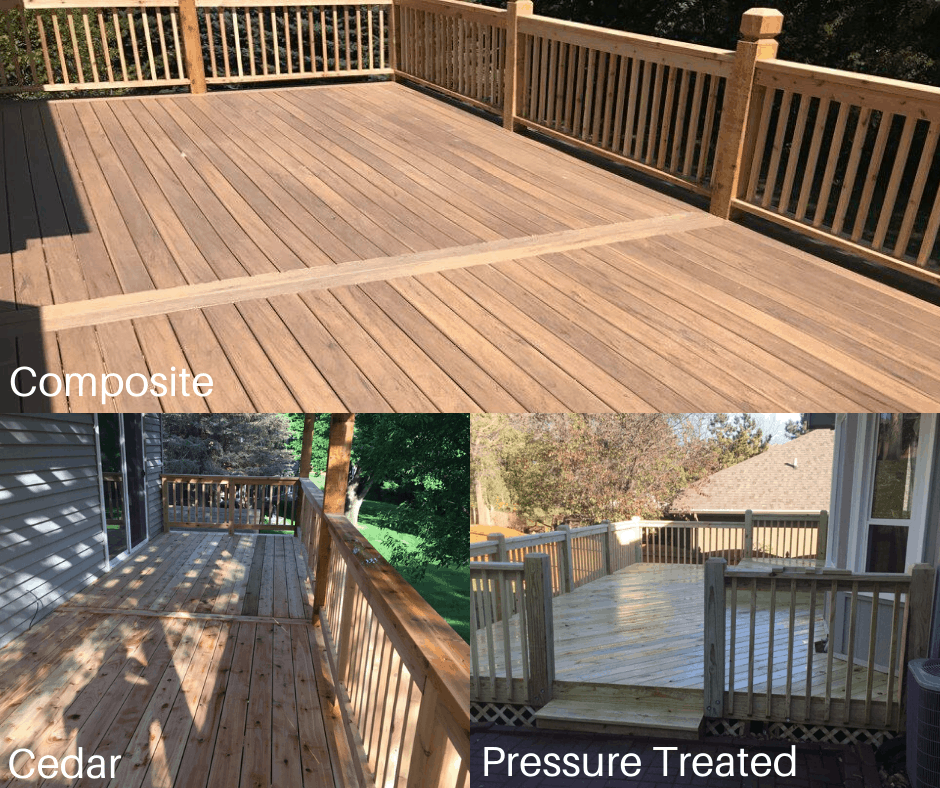If you’ve decided it’s time to have your new deck built this season, one of the first things you’ll want to think about is choosing a deck material that is right for you. There are many different types of deck materials, including pressure-treated wood decks, cedar decks, composite decking also known as “plastic lumber,” aluminum decks, and even decks made with tropical woods.
It can be confusing because there are many choices of deck materials. At All About Decks, we offer three main types of deck building materials, each with their own set of pros and cons. Each can be useful for different types of projects and is good for different budgets.
Pressure Treated Wood Decks
The first type of material we offer for your decking project is pressure treated wood, sometimes known as “green treated wood.” Pressure treated wood is infused with different chemicals through a pressurized cylinder. These chemicals create a resistance to harmful rot and insects.
PROs of Pressure Treated Wood Decks:
- Least expensive option; easy upkeep as it requires only a once a year power washing and then re-sealing every one or two years.
- Pressure treated wood is easy to work with as far as cutting and nailing pieces together so your deck can be built relatively quickly.
CONs of Pressure Treated Wood Decks:
- Splinters can occur when the sealing wears off.
- The slats may warp or crack over time and require you to spend money to have your deck fixed.
Cedar Wood Decks
Cedar is another deck building material we offer for your deck project. This is an excellent option if you love real wood. The natural variety of cedar trees ensures that your deck is one-of-a-kind. We only use the best part of the cedar tree, the deep-colored heartwood.
PROs of Cedar Wood Decks:
- Using cedar, especially the heartwood, will keep your deck from absorbing moisture, making it resistant to rot and warping.
- Relatively inexpensive compared to other wood types like redwood, mahogany, ipe, and tigerwood; cedar decks last longer than pressure treated wood decks, often between 10-20 years.
- Cedar is considered to be one of the most “green” materials because it does not contain chemicals that could be harmful to the environment.
CONs of Cedar Wood Decks:
- To keep its beautiful color, a cedar deck requires staining.
- Cedar is a soft wood, so it is subject to dings and dents more easily than other materials.
- Annual winterizing, consisting of power washing, staining, and sealing, while not required, is highly recommended to maintain the finish and beauty of the cedar.
Some experts suggest that sealing and refinishing your cedar deck every two years is sufficient. Others suggest needing to do it less often. How frequently you need to reseal your cedar deck depends on weather conditions, whether the deck gets a lot of sun exposure, the deck owner’s tolerance for discolorations, and other factors.
Composite Decking Materials
The type of deck building material that offers an endless number of choices is composite decking. Composite decking is either all synthetic or a mixture of natural and synthetic materials, which makes it more durable than all other decking options. If you are looking for the least amount of upkeep, composite is a good choice of material for you.
PROs of Composite Decks:
- Composite decks have a low environmental impact, since they’re mostly made of recycled materials that would have otherwise ended up in a landfill.
- Composite deck materials are available in many colors, looks, and textures.
- They’re stain-resistant, weather-resistant, and splinter-free for those who love to walk barefoot.
- Maintenance of composite decks is minimal, though some composite deck owners have their deck sealed occasionally to protect against fading.
CONs of Composite Decks:
- Since composite decks are made of plastics, polyvinyls, and other plastic configurations, they can look, well, plastic.
- With the latest composite deck technology, however, some composite decks look pretty nice.
- Composite decking materials are generally more expensive than cedar decks and are definitely more expensive than pressure treated wood.
With so many types of deck materials available, the choice isn’t easy. Going through the pros and cons of the different deck materials will help you decide which material is best for your new deck. If you still need help, reach out and we’ll provide all the information you need to decide.
Sources:
Popular Mechanics: https://www.popularmechanics.com/home/how-to-plans/how-to/a3490/4275113/


